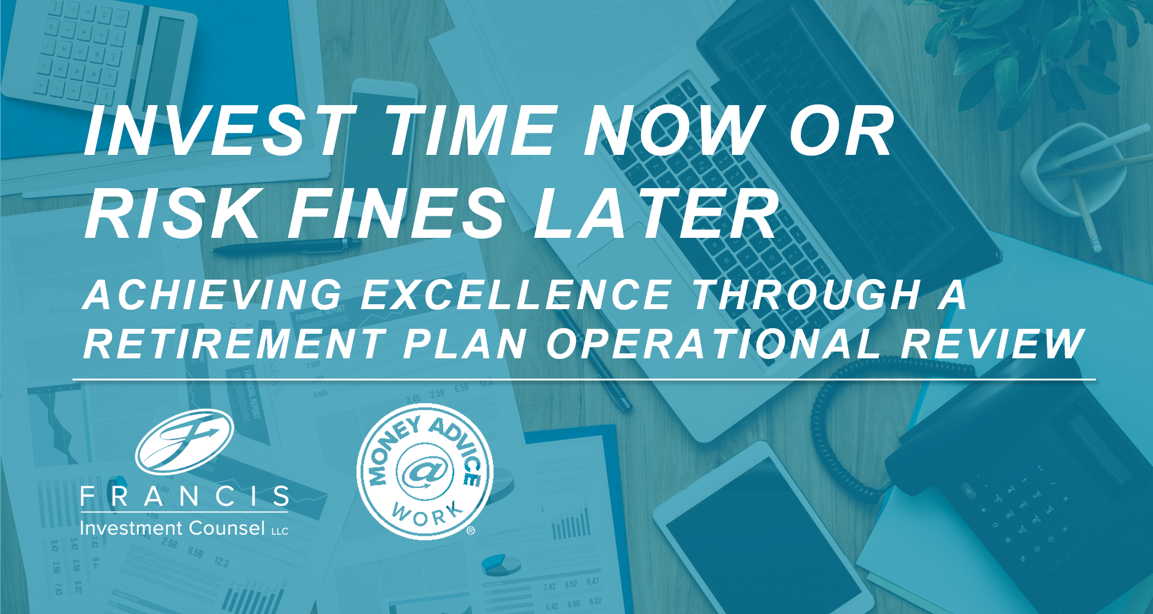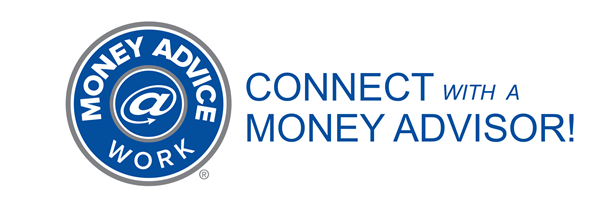
Invest Time Now or Risk Fines Later
In 2020 alone, the Employee Benefits Security Administration (EBSA) – the enforcement arm of the Department of Labor (DOL) – recovered over $3.1 billion from retirement plan sponsors due to plan administration errors and violations. It is an uncomfortable reality for plan sponsors that often their plans are not administered with the vigor required by oversight bodies.
What action can plan sponsors take to improve their plan administration process?
Here we outline a path to operational excellence by conducting a retirement plan operational review. Learn what an operational review is, the steps it entails, and the benefits of the process.
Download and/or print or continue reading.
Retirement Plan Administration is No Yawning Matter
In over 30 years of working with qualified retirement plans, we frequently discover plan sponsors who do not take seriously enough their duty to properly administer their plans. A recent article published by PLANSPONSOR Magazine emphasized this fact.
On the surface, this declaration seems obvious: Of course plan sponsors need to take plan administration seriously. But administering a retirement plan is not as straightforward as most think.
Retirement plans are complex and always evolving. They are also highly regulated, which, at times, contributes to plan sponsors’ stumbles. The world of retirement plan administration can be summarized as good news, bad news, and some downright ugly news that plan sponsors need to know.
Retirement Plan Administration: The Good, the Bad, and the Ugly
First, the Good
Retirement plans are a key employee benefit. When operated effectively, they represent an excellent long-term employee retention tool.
Detailed regulations provide plan sponsors with necessary guidance in how to implement and operate their plans. Efforts continue to increase transparency among retirement plan service providers and improve overall industry oversight.
Even within this regulated framework, most plan sponsors highly customize their retirement plan design. Examples of such customization include automatic enrollment, automatic savings increases, employer match structures, plan eligibility, and distribution rules. This customization is important because it means each plan is uniquely tailored to meet its sponsor’s needs.
Now the Bad
Because of their robust design and ever-evolving regulation, retirement plan sponsors have the complex and dynamic job of administering this benefit.
While all plan sponsors have a plan document to follow, the first problem stems from the fact that the document doesn’t typically cover or define all operational aspects of plan administration. For example, nowhere in the plan document does it say how and who will provide plan participants their required disclosures. And nowhere does it say how fees for plan service providers should be paid or how revenue credits from mutual funds to the plan should be treated.
On top of that, retirement plan administration includes one more very dynamic element: People. Personnel responsible for retirement plan administration must be efficiently integrated into the process.
This, however, is much easier said than done. Human resources personnel come and go, retirement plan committee members turnover, and recordkeeper representatives rarely seem to stay around for more than a couple of years.
With all this shifting personnel, it’s no wonder important details about how a plan is supposed to be administered are forgotten or fall through the cracks.
Brace Yourself: The Downright Ugly
On top of all this complexity, plan sponsors face scrutiny, not only from regulators, but also from their own plan participants. Plan sponsors are held to the high fiduciary standards set forth by the Employee Retirement Income Security Act (ERISA). These include the duty to act prudently, as an expert would; the duty of loyalty, to act in the interest of plan participants; as well as the duty to always follow the plan documents.
The downright ugly truth is that retirement plan administration errors happen. All. The. Time.
There’s no “one thing” plan sponsors are getting wrong. More often than not, mistakes happen due to lack of awareness. Plan sponsors simply don’t know what they don’t know.
We recommend all plan sponsors conduct routine retirement plan operational reviews and establish a plan operational policy. In doing so, we often hear feedback such as ‘I had no idea what that meant,’ or ‘I thought our vendors were responsible for making sure this was done.’
Whatever the explanation for the errors uncovered, make no mistake: In the end, plan sponsors are on-the-hook.
Gain More Insights
Take a Deep Breath – The Ugly Continues
Now, sometimes, when errors are identified, it’s an easy fix. Others, however, may require a formal correction – either by self-correcting or filing formally through the voluntary correction program. A review of common mistakes and the process for formally correcting plan errors can be found on the IRS website through the Employee Plan Resolution Compliance System.
The uncomfortable reality is that few plan sponsors administer their plans with the vigor required by the oversight bodies. For evidence, follow the money: In 2020, the enforcement arm of the Department of Labor (DOL) – the Employee Benefits Security Administration (EBSA) – recovered just over $3.1 billion due to plan errors and violations. The DOL and the Internal Revenue Service (IRS) randomly audit retirement plans each year uncovering these errors, requiring a significant amount of time and dollars to be spent for employers to correct.
The Path to Operational Excellence
Given all of the challenges, how do you know if what you are doing is correct?
The answer is actually quite simple: You have to check.
“Checking” entails a process we describe as a plan operational review. What does this look like? Is it worth the effort? How do you get started?
We’ll explain.
What is a retirement plan operational review?
Stated concisely, a retirement plan operational review is a detailed analysis of how you’re operating your retirement plan. Its goal is to deep-dive into your actual operational practices in order to understand the plan’s provisions, what they mean, parties responsible for execution, and how any unwritten tasks or responsibilities should be assigned.
The end result of a plan operational review isn’t necessarily a concise deliverable, but rather a properly documented and improved process. This exercise helps plan sponsors and their related service partners develop a policy to tactically administer the retirement plan in compliance with the laws and requirements under ERISA, the IRS, and the DOL.
If this sounds like a lot of work that’s because it is. A plan operational review requires a plan sponsor to:
- Thoroughly review the plan document
- Comprehend all provisions and ancillary operational aspects of the plan
- Interview internal staff to understand and explain the duties associated with each aspect of the plan
- Coordinate collaboration with plan service providers hired to assist in the plan administration in order to identify the operational owners of all tasks
- Accurately and succinctly document the review process and its findings
- Act on it’s outcomes for resolution or potential improvements to be implemented
Once the plan operational review is completed, it is not set aside. This outline provides a standing policy you and your partners will rely on or operate by on an ongoing basis. Changes may result due to new plan design features, changes in the law, movement in personnel, or technology enhancements that impact payroll, security, or other aspects of your retirement plan.
This is a lot of work. Is it worth the effort?
The value of the plan operational review process proves itself in the early identification and correction of errors. This identification and correction mitigates the cost of potential penalties. The IRS and DOL audit plans to confirm their compliance. When this audit process identifies errors, the fees for violation and amounts needed to correct or make up for years of potential mistakes can be extensive.
In contrast, a proactive plan operational review grants plan sponsors the benefit of time. They can correct and fix the problem while properly and prudently documenting the process.
The Benefit is Greater than Avoiding Costly Mistakes
Mitigating the risk of errors and expensive fixes is certainly worthwhile. The greatest impact of a retirement plan operational review, however, resides in the people involved with the process. Involving internal staff and plan service providers strengthens these important relationships.
Moreover, the experience of collaborating through the review process is educational and camaraderie-building for all personnel involved. It creates consensus of mutual ownership while delineating exact responsibilities. Finally, the collection of insights from this process in the form of an operational policy initiates a rhythm of regular review.
Conducting a plan operational review is no small task, but in the end, plan sponsors gain peace of mind. The process facilitates effective plan administration that improves internal controls, documents necessary activities, and identifies responsible parties. It also verifies ongoing compliance given inevitable changes to regulations, plan design, and personnel responsible for day-to-day administration.
How to Get Started
For a plan sponsor looking to complete a plan operational review, we recommend getting started with the following three steps.
Step One: Review who is involved in the administration of your retirement plan
Before getting started, plan sponsors need an understanding of what parties affect the retirement plan. There are five main groups typically involved:
1) The Plan Sponsor: The company – through its human resources, finance, and legal personnel – that decides to offer a retirement plan benefit to its employees
2) The Retirement Plan Committee: Decision makers and fiduciaries who are responsible for monitoring, evaluating, and overseeing the plan’s operation
3) The Plan Recordkeeper: Hired to administer and recordkeep participant accounts, track who’s in the plan, what investments they own, host a participant website and call center, and play an active role in maintaining the plan’s compliance
4) The Retirement Plan Consultant/Investment Advisor: Third-party expert and plan fiduciary, responsible for guidance, oversight, and monitoring of the investment menu, plan operations, and plan fees
5) The Participants: Individuals who participate in the retirement plan and ultimately the ones the other groups detailed are providing services for and working in the best interest of
Once identified, plan sponsors then know who to seek in this collaborative process.
Step Two: Create a plan operational outline
It’s difficult to begin a process without a vision of where it leads. For this reason, we recommend creating a plan operational outline. This outline will guide your review process, ensuring you uncover the information you need.
Ideally, a plan operational outline reviews and compares a plan’s written provisions and internal processes. It further summarizes the daily, quarterly, annual, and ad-hoc activities required and identifies the operational owner assigned to perform each of those duties.
To begin constructing this outline, focus on the following areas:
- Reassess plan design features and processes such as eligibility, definition of eligible compensation, automatic features, payroll, and timing of employee deferrals
- Identify person responsible for the administration of each plan task
- Ensure plan documents and amendments are properly dated and signed
- Verify all plan provisions are correctly reflected in annual required notices and enrollment materials
- Initiate a discussion with your recordkeeper and third party administrator (if applicable) to walk through plan documents, review notices, and analyze compliance testing
- Review service providers’ contractual provisions and data privacy guarantees
Step Three: Acknowledge when outside expertise is needed
Even the most competent plan sponsors can feel in over their heads when it comes to retirement plan administration. Sometimes you can get some much needed help through your retirement plan recordkeeper, but rarely will this service partner provide a deep-dive outside of a plan conversion process.
If you feel overwhelmed or have an unsettling suspicion that things aren’t quite right, your best move may be turning to outside consultation.
The team of experts at Francis Investment Counsel has decades of experience working with retirement plan sponsors and recordkeepers to ensure effective plan operation and compliance. Don’t take the risk of hesitating. Reach out to our team for guidance on your retirement plan review process.
Sources:
PLANSPONSOR Magazine, “Avoiding Retirement Plan Operational Errors,” 2021.
U.S. Department of Labor, “Employee Retirement Income Security Act (ERISA).”
Internal Revenue Service, “EPCRS Overview,” 2021.
U.S. Department of Labor, “U.S. Department of Labor Restores Over $3.1 Billion to Employee Benefit Plans, Participants and Beneficiaries, the Most Ever,” 2020.
The information/summary/prices/quotes/statistics contained herein have been obtained from sources believed reliable but are not necessarily complete and cannot be guaranteed. Past performance results are not necessarily indicative of future results. Francis Investment Counsel does not provide tax or legal advice.



